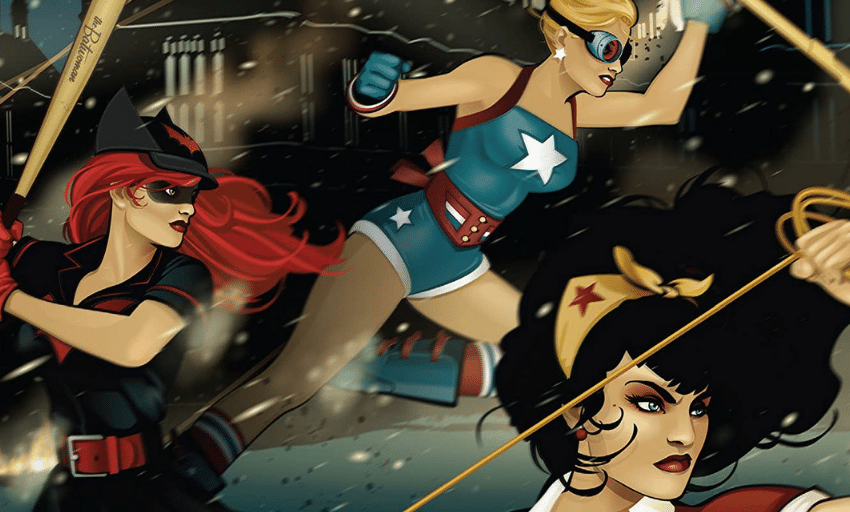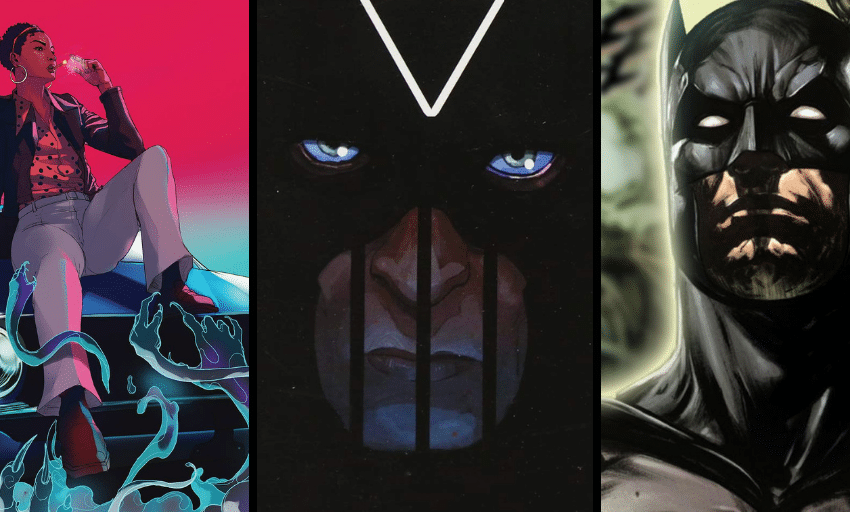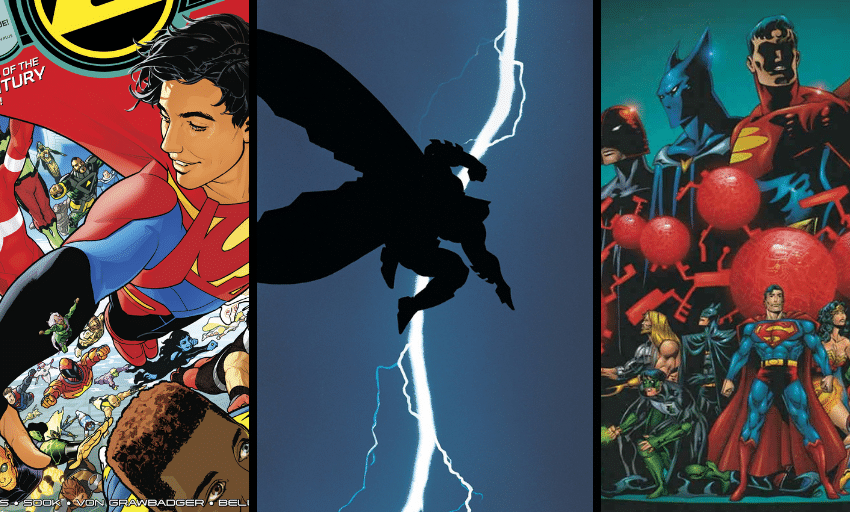The Kuberts are the first family of comics. Joe Kubert produced comics from 1943, the heart of the Golden Age, until right before his death in 2012. His sons, Andy and Adam, have been two of comics’ best regarded artists for over 20 years. His granddaughter Katie Kubert has edited for both Marvel and DC. And another of his granddaughters, Emma Kubert, was our guest on WMQ&A this week, to talk about her new Image series with co-creator Rusty Gladd, “Inkblot.” For this week’s Bonus Reading, we’ll look at some of the highlights of the careers of the Kuberts.

Joe Kubert was born in 1926 in Poland, but his parents emigrated to the U.S. when Joe was 2 months old. Joe’s first published work was when he was between 10 and 12 years old, for MLJ, the company that would become Archie Comics.
Joe moved over to superhero comics and found a home at DC. Early in his career, he did stories featuring the Seven Soldiers of Victory and then Hawkman, whom he would be associated with for decades to come. Joe would work at other companies throughout the ’40s and ’50s as well, creating Tor, a prehistoric man, with Norman Maurer, a character that Kubert would write and draw until the 2000s.
When the Silver Age rolled around, Joe co-created some of his most famous characters. He inked the story many say ushered in the era, the first Barry Allen Flash story in “Showcase” #4. He would go on to co-create the Silver Age Hawkman, the alien Katar Hol version, with Robert Kanigher. But it was his work on war comics with Kanigher where Kubert would create the character he is most associated with. In “Our Army at War” #82, Kanigher and Kubert created Sgt. Frank Rock, DC’s hard-nosed World War II soldier. He would also co-create the World War I German flyer Enemy Ace, and would pencil stories featuring the Unknown Soldier and the Haunted Tank, but it was Rock who would be Joe’s seminal creation.

Later in his career, Joe would not just continue to return to characters like Hawkman, Tor and Rock but begin producing original graphic novels. These include “Yossel,” a work of speculative fiction where his family didn’t leave Poland and they were taken to the concentration camps by the Nazis; “Fax From Sarajevo,” a graphic narrative based on the faxes he received from comics agent Ervin Rustemagić, who was trapped in Sarajevo during the Serbian conflict in the early ’90s; and “Jew Gangster,” the story of a young Jewish man and his time in and around the mob starting during the Great Depression.
I had the honor of meeting Joe at one of the last signings he did before he died. It was at Dewey’s Comic City in Madison, New Jersey, and it was one of the best signings I’ve ever attended. Joe was charming and gracious, signing copies of the recently released paperback of “Jew Gangster” and chatting with all the people who came out to see him. Dan Veltre, then owner of Dewey’s, was over the moon to have this legend at the store, and to complete the trifecta at that point, since he had already had both of Joe’s artist sons, Andy and Adam, do signings there.
Writing about Andy and Adam Kubert on what started as a site about the X-Men seems somewhat redundant, as the two sons of Joe have spent much of their careers associated with the X-books. But they didn’t start that way. Their first works followed right in their dad’s footsteps, each doing a story in back-to-back issues of “Sgt. Rock” in 1984. They would then work together on a couple projects, with Andy pencilling and Adam inking “Doc Savage: The Silver Pyramid,” a miniseries written by Denny O’Neil, and the first “Batman Vs. Predator” miniseries. Adam also colored Andy’s pencils on “Adam Strange: The Man of Two Worlds.”

At the same time the Kuberts were working on the last of these projects, they began working for Marvel, and this is what elevated them from well-regarded legacy creators to A-list talent. Andy filled in for Jim Lee toward the end of Lee’s run on “Uncanny X-Men,” and would become the new regular penciller of the adjective-less “X-Men” title after Lee left, staying on the book for nearly 40 issues. He penciled “Captain America” for two years, and then worked on two of Marvel’s marquee miniseries of the early ’00s: “Origin,” the revelation of Wolverine’s origin with writer Paul Jenkins, and “1602,” the recasting of the Marvel universe in the 17th century with writer Neil Gaiman.
Adam’s first major Marvel work was a yearlong run on “Ghost Rider/Blaze: Spirits of Vengeance,” before pencilling another of the X-books, “Wolverine,” starting with the landmark 75th issue, where Wolverine deals with the loss of his adamantium in “X-Men” #25 (penciled by Andy). Adam would continue to pencil Wolverine through issue #100, so he is the artist who first drew the infamous noseless, devolved Wolverine. He penciled both bookends to 1996’s “Onslaught” event, and then became the last regular penciller on Peter David’s decadelong run on “The Incredible Hulk.” Adam penciled “Uncanny” during the lead-up to “The Twelve” story through the beginning of Chris Claremont’s first return to the series. He wrapped up his first tenure at Marvel as one of the first pencillers on the Ultimate line, penciling early arcs on “Ultimate X-Men” and “Ultimate Fantastic Four.”
In 2005, both brothers signed exclusive contracts with DC and went on to draw two of the company’s biggest sellers of the time. Andy was the first penciler on Grant Morrison’s run on “Batman,” while Adam penciled Geoff Johns and Richard Donner’s first issues on “Action Comics.” Andy also penciled the universe-altering “Flashpoint” event (and, by the way, if you look at the first page of issue #4, you’ll see a comic shop named Dewey’s as a fun Easter egg for the Kubert School’s local comic shop). Both brothers also have written some, with Andy writing and drawing a miniseries focusing on a possible future for Damian Wayne, Batman’s son, and Adam writing a Sgt. Rock strip for DC’s weekly “Wednesday Comics,” penciled by his father. Adam returned to Marvel after his exclusive was up, most recently penciling the new volume of “Wolverine.”

Katie Kubert hasn’t followed her grandfather and uncles down the path of the comic book artist but is no less involved in the industry. After graduating from Boston University, Katie worked her way up the editorial ranks at DC, where she edited a number of Batman titles, including “Batgirl,” “Grayson” and “Harley Quinn” (and got a cameo when Harley went to Comic-Con for a one-shot), and in 2014 moved over to Marvel, where she edited a number of Guardians of the Galaxy- and Squadron Supreme-related projects, and the weekly “Wolverines” series and other spin-offs of “The Death of Wolverine.”
Now, all of those highlights are impressive, and any one Kubert’s CV would make them a legend in the industry. But possibly the most impressive thing the Kuberts have done isn’t in the pages of comics. No, the most impressive thing Joe probably ever did, and that his sons kept going, was the Joe Kubert School of Cartoon and Graphic Art. Established in Dover, New Jersey, in 1976, the Kubert School is a three-year program designed to teach the basics of graphic storytelling, as well as some fine arts and other training, to prepare artists to work in any number of illustration fields, although some of their best known alumni are comic book artists.
The Kubert School’s first graduating class set the tone for what was to come, as it included Stephen Bissette and Rick Veitch, who would, along with many other accomplishments, go on to work with Alan Moore on his seminal run on “Saga of the Swamp Thing.” Other notable alumni are Amanda Conner, Jan Duursema, Tom Mandrake, Eric Shanower and Lee Weeks. The faculty of the school includes working artists, not just the Kuberts themselves but Fernando Ruiz, longtime Archie artist and co-creator of “Die, Kitty, Die,” and regular guest lectures from alumni. And while the school has passed into new hands, with artist and alumnus Anthony Marques purchasing it a year ago, the legacy of the Kuberts will continue through family members and the many students who have graced the halls of the school.
Matt Lazorwitz read his first comic at the age of five. It was Who's Who in the DC Universe #2, featuring characters whose names begin with B, which explains so much about his Batman obsession. He writes about comics he loves, and co-hosts the creator interview podcast WMQ&A with Dan Grote.






